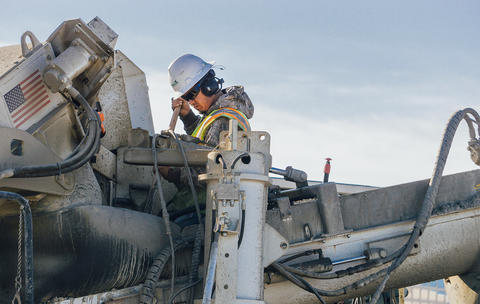Exactly how loud is that jackhammer?
NIST calibrations help OSHA maintain healthy hearing in the workplace

When a jackhammer starts pounding outside your window at 7 o’clock on a Monday morning, you might find it annoying. For the worker who is running that jackhammer, however, the sounds are more than annoying – without proper hearing protection, they can be dangerous.
Occupational hearing loss is the most common work-related illness in the U.S. Each year, 22 million workers are exposed to hazardous noise, according to the National Institute for Occupational Safety and Health (NIOSH), which does research for the U.S. Centers for Disease Control and Prevention (CDC).
The first step toward protecting workers from occupational hearing loss is knowing how loud those sounds really are. The U.S. Department of Labor’s Occupational Safety and Health Administration (OSHA) does regular assessments to identify hazardous noise levels. But the equipment that OSHA uses has to be calibrated periodically, to make sure that it is performing correctly.
The National Institute of Standards and Technology (NIST) recently calibrated one of OSHA’s standard microphones, a procedure that NIST has completed regularly, since the 1970s, for a group of standard microphones belonging to OSHA. These calibrated microphones are in turn used by OSHA to calibrate nearly ten thousand pieces of OSHA’s own equipment, which includes sound level meters and noise dosimeters used to monitor sounds in the workplace as well as acoustical calibrators used to calibrate the sound level meters in the field.
“Millions of workers are exposed to noise in the workplace every day and when uncontrolled, noise exposure may cause permanent hearing loss,” according to OSHA. “Under the Occupational Safety and Health Act of 1970, employers are responsible for providing safe and healthful workplaces for their employees. OSHA's role is to ensure these conditions for America's working men and women by setting and enforcing standards, and providing training, education, and assistance.”
To perform the calibration for OSHA, NIST scientists measured the mic’s sensitivity through comparison to NIST standard microphones that have already been calibrated.
Calibrating the Calibrators
Sound is pressure waves traveling through a medium such as air. A microphone is a device that takes those pressure waves and turns them into an electrical signal – a voltage.
To calibrate a microphone, researchers need to measure how sensitive it is to those pressure waves. The same sound will cause a more sensitive microphone to produce a bigger voltage signal than a less sensitive microphone under the same conditions.

The first step toward calibrating an OSHA microphone is calibrating the NIST standard microphones themselves. Scientists do this using a technique called “reciprocity.”
Standard microphones like the ones NIST uses for the OSHA calibrations are special. Unlike the mics you might use for a conference call or karaoke night, these NIST standard microphones are able to perform in the calibration as either a receiver or as a transmitter – essentially a loudspeaker.
In a reciprocity calibration, transmitter and receiver mics are connected to each other via a small hollow cylinder called an acoustic coupler. One standard mic produces a sound that the other standard mic picks up. Scientists then measure the difference between the input voltage used to drive the transmitter mic and the voltage coming out of the receiver mic.*
After a measurement has been taken, the microphones’ positions can be swapped, with the transmitter acting as receiver and vice versa.
This process is repeated several times, using a total of three standard microphones. By exchanging the mics’ roles between measurements, researchers can be sure of the sensitivity of each of the three microphones without the need for a previously calibrated microphone.
Minimizing ‘Noise’ in A Noise Measurement
But there’s more to reciprocity than just measuring voltages, because sound waves are affected by the medium – usually air – through which they travel. For each measurement, scientists carefully evaluate the characteristics – such as the barometric pressure, temperature, and relative humidity – of the air** inside the acoustic coupler. They also determine the total volume of the space inside the acoustic coupler itself, since sound waves are also affected by the coupler’s volume and geometry.***

Once the standard mics are calibrated by reciprocity, they can be used to calibrate an OSHA microphone by what NIST’s Randy Wagner calls a “reciprocity-based comparison.” In this case, the OSHA mic being calibrated is only used as a receiver, while each NIST standard mic is only used as a transmitter.
During a calibration, NIST scientists use their standard mics to play pure tones over a wide range of audible frequencies.
“Over most of the frequency range, we can give the customer uncertainties that are below a tenth of a decibel (dB),” said Wagner, who performed the OSHA mic measurements.****
Through a chain of calibrations, the measurements performed at NIST can ensure the performance of OSHA field instruments that measure workplace noise levels created by everything from a contractor’s pile driver to a barista’s espresso machine.
* Technically, scientists are measuring the ratio of the input voltage used to drive the transmitter mic and the voltage coming out of the receiver mic.
** Instead of air, sometimes another gas, such as hydrogen, is used.
***Among other things, the coupler is designed to ensure that the pressure waves traveling through the air provide an approximately uniform pressure distribution across the surface of the receiver mic.
**** In acoustics, the decibel (dB) is a unit of sound pressure level that is used to express the relative amplitude of a sound. Its scale is logarithmic to accommodate the large dynamic range of sound that humans can hear. It is also used as a unit of sensitivity level for a microphone, in which case it expresses the ratio between two quantities: the microphone sensitivity (in volts per pascal) and a reference sensitivity (1 volt per pascal).
-- Reported and written by Jennifer Lauren Lee

